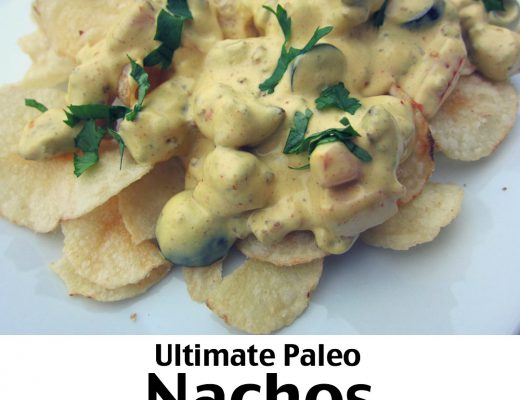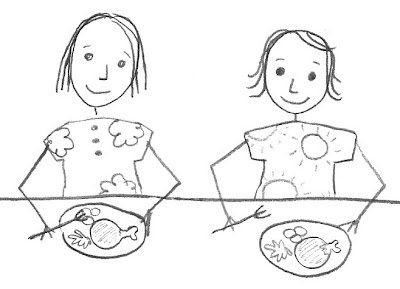Wednesdays used to be our Guest Blogger Series day; but, there’s just so many new and wonderful Paleo and real-food bloggers out there that we’ve expanded our series. We hope you enjoy the new view points and unique content; if so, we encourage you to show these guest bloggers your support by visiting their blog and social media links at the end of this post!
This week, as a follow up to Episode 33 of The Paleo View, Arsy of Rubies and Radishes gives us a post on what to give babies as their first foods. Arsy is the author of The Paleo Slow Cooker and previously contributed to Paleo Parents with her Berry Rhubarb Maple Crisp in February. Please visit her blog if you are a fan of fantastic photos and delicious dishes!
Please note, Stacy wrote an old series on Baby Led Weaning that ties nicely to this. Important to remember, “signs” of baby being ready aren’t just a nominal curiosity of food or development of teeth. Babies need to be able to sit up up on their own, use a pincer grasp to put food in their own mouth, and swallow effectively – make sure they’re not tongue thrusting food back at you!
♥♥♥
I have always been a food lover and adapting a Paleo lifestyle has helped me appreciate it and enjoy it even more. Naturally, I was very excited about introducing solid food to my daughter, so I started researching first foods early on in my pregnancy. The approach we take is two-fold. First, we emphasize nutrient dense foods in her diet and second, we want to create an environment where she learns to relax and enjoy her meal.
Every baby deserves to be healthy and is entitled to their health. I believe it is something that every parent wants to provide for their child. Unfortunately, we are often misguided by the massive amount of misinformation in mainstream literature. Many pediatricians recommend introducing iron-fortified rice cereal as baby’s first food. This is because they believe rice to be a low allergenic food, and some babies need additional iron other than mom’s milk after 6 months. Babies have enough iron stored for at least the first 6 months, even longer if breastfed.
A major problem with starting babies off on rice cereal is that grains are very difficult for babies to digest. One reason for this is because babies do not make enough amylase, the enzyme needed to break down carbohydrates. Babies develop enzymes as their digestive system matures. So, not only is rice cereal lacking in nutrients, it is also harsh on a baby’s developing digestive system.
Many cultures introduce animal foods first, including American culture historically. Animal foods provide the most absorbable nutrients and babies produce the enzymes and stomach acid needed to break down proteins and fats. Animal foods also provide complete protein, cholesterol and healthy fats. Grains, legumes and even green-sources of protein are always lacking in one or more essential amino acids. Cholesterol is critical to the formation of the brain and nervous systems, as well as the digestive tract. Children need healthy fats to grow and develop. Fats are often rich in the fat soluble vitamins, A, D and K. These are essential for normal growth and hormone production. Meat is also a great source of zinc, iron and B-vitamins.
Whenever possible, choose organic. According to the Weston A. Price Foundation, babies are more “vulnerable to pesticide exposure because their organs and body systems are not fully developed and, in relation to body weight, they eat and drink more than adults”.
So, what are some ideal first foods for our babies?
Soft-boiled Egg Yolks provide cholesterol, which is critical for the development of the brain and nervous system. They are a great source of choline, which is an important nutrient that we don’t often hear about. It is important for brain cell development, as well as nerve and liver function. Whenever possible choose eggs from pasture feds hens, these will also be richer in omega-3s. Egg whites can be highly allergenic and should be avoided until the age of 1.
Liver is nature’s true super food. Liver is a powerhouse of nutrients. It is a great source of cholesterol. It’s loaded with vitamins and minerals, including choline, iron, B-vitamins, D3 & K2. K2 is a very important nutrient that we don’t find in many foods. It contributes to the development of strong bones and teeth and even the facial structure. It is also important for energy production in the body. Organic & Grass-fed varieties are best!
People often ask me how to serve liver. You can grate organic, raw liver into egg yolks. If using this method, make sure to freeze the liver for 14 days, in order to kill any pathogens. A second option, which is what my daughter prefers, is to brown it lightly with some ghee and use bone broth to thin it to your desired consistency. We sprinkle it with a little sea salt too for additional minerals and flavor.
Bone-broth is rich in collagen, gelatin, amino acids and many minerals. The calcium in bone broth is in a form that is very easy for the body to absorb and digest. The gelatin also has many benefits, including improving digestion and soothing the GI tract. In addition, it has been found to build strong cartilage and bones and it has benefits for the skin, immune system and heart.
Fermented Cod Liver Oil is a great source of the Omega-3 fatty acid, DHA, as well as the fat soluble vitamins, A, D & K2.
Mashed Banana is one of the few carbohydrates that naturally contain amylase, making it easier for babies to digest. Choose ripe, spotted ones.
Mashed Avocado is a rich source of quality fat.
After about a month or when your baby seems ready, you can start adding a larger variety of foods. Below are some good options.
Grass-fed butter and ghee contain vitamin A, E & K2.
Coconut oil: Is a great source of healthy fat and it is an excellent source of lauric acid, only second to breast milk!
Pureed or strained beef: Braise the meat in bone broth, then puree or strain it to make it more digestible for the baby. It’s best to choose grass-fed meat to maximize nutrients and avoid antibiotics and hormones.
Bone marrow: Is another great source of quality fat, that is loaded with nutrients and has a delectable taste.
Sweet potato, squash, carrots, parsnips and rutabagas: Are vegetables that are easy to digest, but should always be served cooked to young babies. It is important to serve these with healthy fats, to help the baby absorb the fat soluble vitamins available. We usually cook ours in homemade bone broth, so the vegetables can soak up minerals from the broth and become more digestible.
Tropical fruits: Are also a good early food because they are high in enzymes, making it easier for the baby to digest. Cantaloupes, mango and papaya are good options.
A book I highly recommend when introducing solids is Super Nutrition for Babies. It is a very comprehensive and thoughtfully written book with appropriate foods to introduce at each stage, recipes and suggested schedules.
Some additional tips:
- Wait until your baby is ready. Observe your baby, when they are ready for solids they will act interested in food. All babies are different and will be ready at different times. Introducing solids at six months is a good rule of thumb, but some babies are ready a bit earlier and some a bit later. Trust your baby’s signals.
- Introduce a new food every few days , not sooner, and observe your baby for adverse effects. Since their digestive systems are immature, they can even react to healthy food.
- Offer the same food many times. Solid foods are a very new experience for babies and the new flavors are exotic. It often takes our daughter 2-3 times before she enjoys a new food, but I have read that it can easily take 10-15 tries.
- Never force food. If a baby doesn’t seem ready for solids or a new food they will turn their head away or refuse to open their mouth. Do not pressure them to try it, just nonchalantly remove the food.
- Don’t praise for eating. We never tell our daughter she did a good job. We don’t want her to learn to associate eating with receiving praise, we want her to eat because she is hungry.
- Encourage mindful eating by creating an environment with minimal distractions and make eating a relaxing, intimate and stress-free experience!
For further reading:
- Super Nutrition for Babies by Kelly Gelzinger and Katherine Erlich, M.D.
- The Nourishing Traditions Book of Baby & Child Care by Sally Fallon Morell and Thomas S. Cowan
- Nourishing a Growing Baby by Jen Allbritton, CN
 Arsy Vartanian is the author and chef of the paleo recipe & lifestyle blog, Rubies & Radishes and the cookbook, The Paleo Slow Cooker. In an effort to achieve optimal health and wellness, she discovered Crossfit & the paleo diet in 2008. Arsy started feeling better than ever and was eventually able to recover from health issues that she had struggled with for almost a decade. Equipped with this energy and knowledge, Rubies & Radishes was born.
Arsy Vartanian is the author and chef of the paleo recipe & lifestyle blog, Rubies & Radishes and the cookbook, The Paleo Slow Cooker. In an effort to achieve optimal health and wellness, she discovered Crossfit & the paleo diet in 2008. Arsy started feeling better than ever and was eventually able to recover from health issues that she had struggled with for almost a decade. Equipped with this energy and knowledge, Rubies & Radishes was born.
When Arsy is not busy at her day job or being a mom to her new baby, you can find her in her kitchen developing healthy recipes for her family and her blog readers. Connect with Arsy on Facebook, Twitter & Instagr







